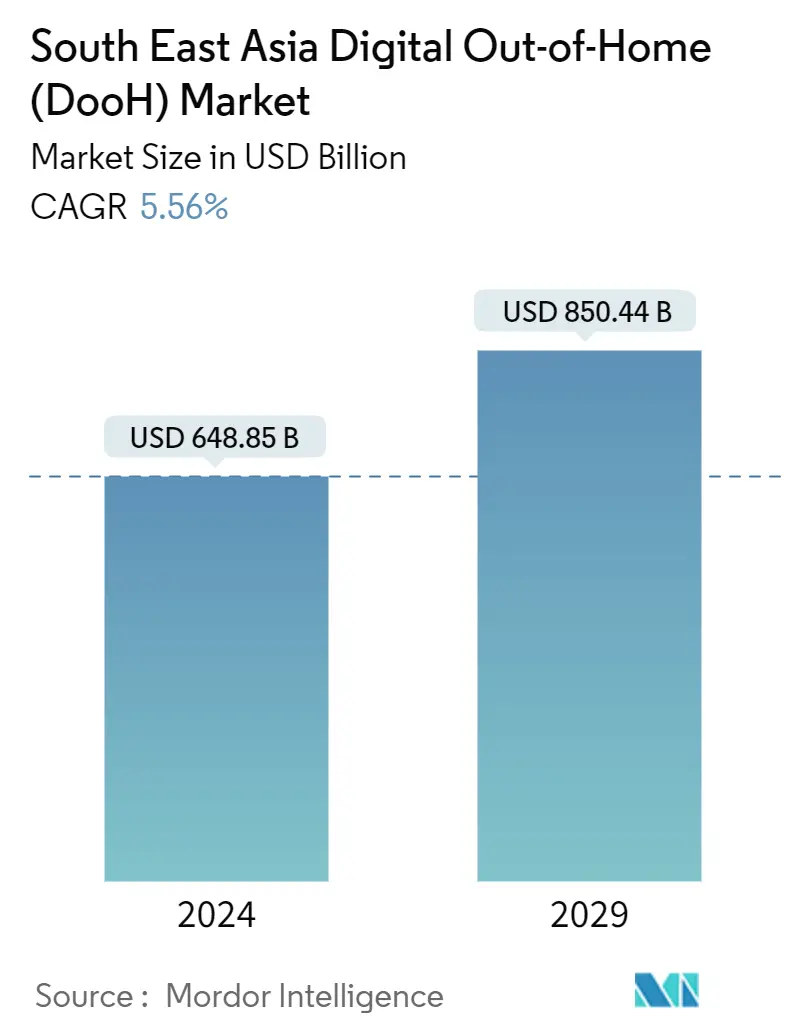Market Size of South East Asia Digital Out-of-Home (DooH) Industry

| Study Period | 2019 - 2029 |
| Base Year For Estimation | 2023 |
| Market Size (2024) | USD 648.85 Billion |
| Market Size (2029) | USD 850.44 Billion |
| CAGR (2024 - 2029) | 5.56 % |
| Market Concentration | Low |
Major Players_Market__company_logog.webp)
*Disclaimer: Major Players sorted in no particular order |
Need a report that reflects how COVID-19 has impacted this market and its growth?
South East Asia Digital Out-of-Home (DooH) Market Analysis
The South East Asia Digital Out-of-Home Market size is estimated at USD 648.85 billion in 2024, and is expected to reach USD 850.44 billion by 2029, growing at a CAGR of 5.56% during the forecast period (2024-2029).
DooH advertising is out-of-home advertising that is powered by digital signage technologies. These technologies use AI and analytics to help marketers get the right message to the right people at the right time.
- The offline advertising business is slowly adopting new technologies, like geofencing and beacons, which make tracking and customization possible in ways that weren't possible before. This is helping the market grow significantly.
- DooH is being used in the right places for many reasons, such as how easy it is to manage, how quickly it can be changed, how cheap it is, how well it can target a market, and more. Advertisers and marketers can use DooH to send multiple pieces of information to a network of devices and connect to these devices remotely to update their content. Because of government restrictions on offline shopping, COVID-19 caused a big loss for the DooH advertising business.
- DooH allows sellers in the region to modify the displays and communications more rapidly and allows the information to reach potential buyers at a lower cost and with better effectiveness. Additionally, it is simple to manage in comparison to conventional advertisements. Digital signs provide up-to-the-minute details on products and accessibility, interactive information, and visually appealing images and videos.
- Smart city projects use different kinds of digital displays to make sure the city runs smoothly, and every digital display can be used to make money from ads. Digital signage technology assists in capitalizing on these prospects. From small interactive kiosk screens to large-format digital billboards, systems deliver the computing performance, high-quality graphics, and connectivity needed to make an impression and the analytics needed to disclose critical information.
- Furthermore, the region has been witnessing expansions from global companies, as they offer lucrative opportunities to the solution providers for development and growth. For instance, in August 2022, Vistar Media announced the deployment of full programmatic capabilities in Indonesia, Malaysia, the Philippines, and Hong Kong. This broadens the company's already established presence in the APAC area, which includes Singapore, Australia, and New Zealand. The major source of programmatic demand transactions for digital out-of-home is the Vistar Demand-Side Platform (DSP). Through both open exchange and private marketplace partnerships, advertisers and agencies in Southeast Asia may now use the Vistar DSP to design, purchase, and assess data-driven out-of-home (ooH) campaigns.
- User engagement with DooH is difficult to quantify because counting exact DooH impressions is impossible. While vendors can predict traffic near a specific outdoor ad using smartphone location data, it may not be an exact count, and it does not include the integration of face recognition to establish people's gender and age who have already seen the advertisements, which makes the implementation more complex and hinders the market's growth.
- Even though COVID-19 helped news publishers get more traffic and increase the value of their digital inventory, programmatic CPM fell because of concerns about brand safety in COVID-19 content.
